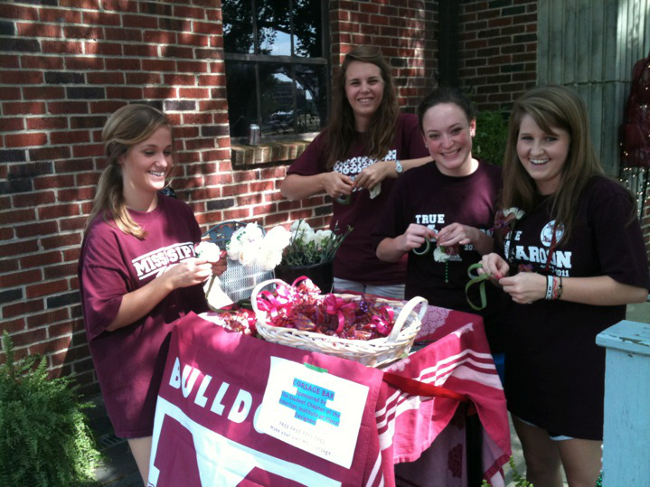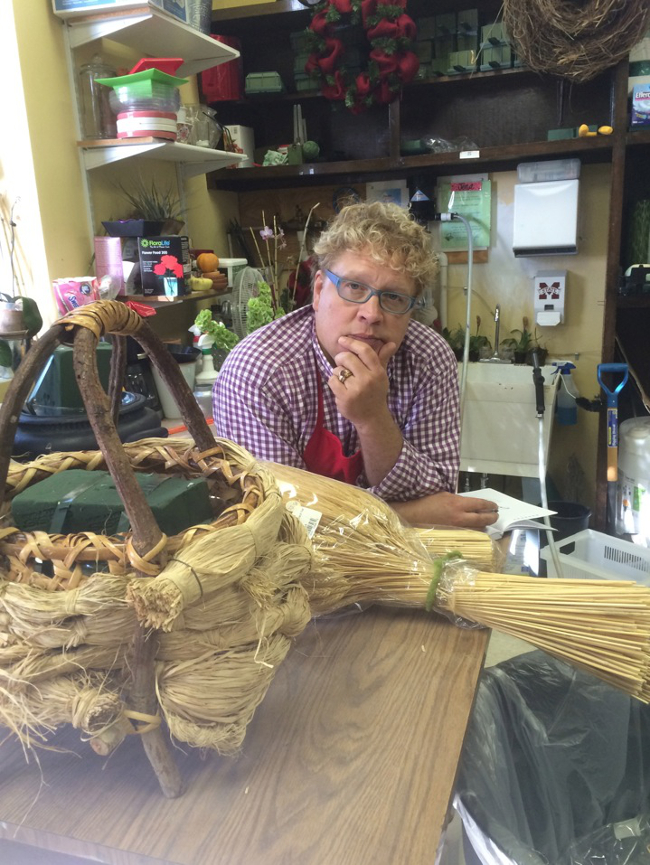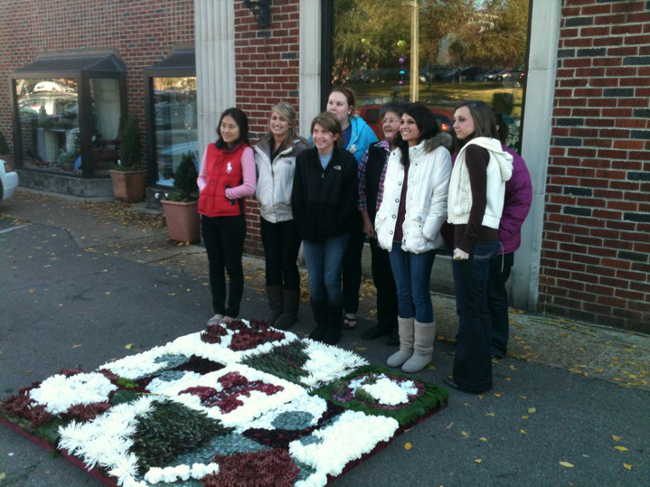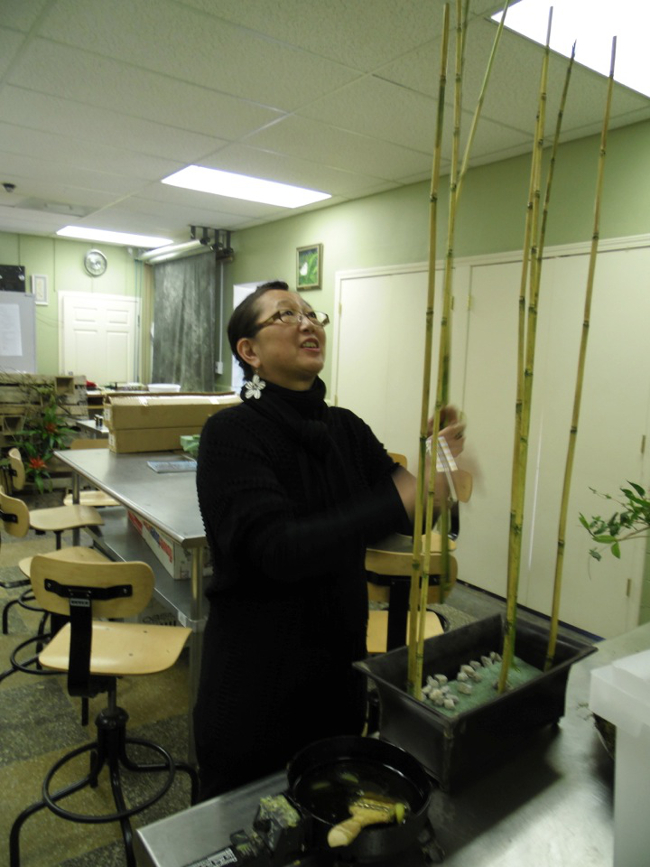Mississippi State University and Dr. James M. DelPrince, Ph.D., AIFD, PFCI are not just staples of a strong history of degree level floral education but one of the last major American Universities offering floral education programs. With the onsite flower shop, The University Florist, and 20 Floral Management concentrated majors offered by MSU and Dr. DelPrince, students are guaranteed to be prepared to go into floral careers throughout the industry ranging from retail, wholesale to media and product development.
Assistant Professor of FLoral Design Opening Click Here for more information!
Floral Management is a concentration in the Horticulture major, Department of Plant and Soil Sciences, within the College of Agriculture and Life Sciences. Mississippi State University is a Land-Grant Institution of Higher learning located in Starkville, Mississippi.
YOU CAN FIND ALL THE CONTACT INFORMATION FOR Mississippi state university and Dr. delprince AT THE END OF THE ARTICLE

Members of MSU’s Student Chapter of the American Institute of Floral Designers offer football game attendees corsages in the school colors of maroon and white, celebrating and continuing a football tradition.
What advice do you have for designers looking to become a university floral educator or advisor?
Universities generally require a terminal degree in the applicant’s area of expertise. To become a university professor, a doctorate may be required in the area of expertise or related area. Some university faculty hold positions with master of arts or master of sciences degrees if the job allows. Generally, the parent department of the program of study sets employment guidelines. Floral design teaching is usually situated in departments where horticulture science is taught; hence a dominant environment of science may surround teaching and presentation of floral design for the faculty member.
Another strong consideration is whether or not the job is tenure track. Tenure is a career long contract with the university and can only be obtained through regular, rigorous evaluation based upon the faculty member’s performance in the tripartite mission of the U.S. Land Grant system. This involves high levels of performance in teaching, research and service. Not all floral design teaching positions in higher education are tenure track.
Not all Land Grant institutions have floral design programs or even singular courses. Departments, colleges and the university itself must realize a need for such study, develop proposals from faculty within, review and approve the proposals. Such proposals require a demonstrated need for the courses, faculty and administrator support, and much time, measured in years, for development. Being a university faculty member at a Land Grant Institution entails understanding and skills in floral design along with commitments to scholarship, teaching and service.
Beyond teaching floral design theory and practice, floral design faculty must develop scholarship through academic writing, juried exhibitions and/or other creative outputs on par with peer reviewed journal articles. Interaction with members of the community and beyond such as community workshops, floral industry organization leadership, trade journal writing and garden club demonstrations illustrate some of the types of service that constitute university outreach. Teaching may involve formal courses in floral design, from foundational, survey-type courses for horticulture majors and others, to advanced courses in wedding floral, permanent botanical and others.
A floral design instructor/professor may have other teaching assignments such as to oversee the operations of an on-campus retail floral shop, horticulture courses (for example, introduction to gardening, interior plantscaping), student advising and more. A faculty position at a college or university is dynamic and challenging every day. It requires a sincere effort to continually build the program through better teaching, scholarship and outreach.

Ty Leslie, AIFD, of Charleston, South Carolina has been an AIFD Artist in Residence. Dried floral materials courtesy Knud Nielsen Co., Evergreen, Alabama.
Who have been some of the most influential floral industry guest speakers that Mississippi State University has hosted?
Over the years, MSU has hosted dozens of high-profile, creative floral designers to demonstrate construction and offer educational business advice to our students and beyond.
A brief list includes: Coble, Kevin Dennis, Roger Gilliam, Hitomi Lemanski, Carl Leslie, Ty McGukin, Sharon Null, Ralph Poeltler, Julie Pollitz, Rocky Proctor, Tracy Raulerson, Brooke Schwanke, J Shelton, Frankie Smith, Joseph Vetter, Brian Wood, Matt Yanos, Emil Gary Wells As an active Student Chapter of the American Institute of Floral Designers, MSU is required to host at least one Artist in Residence program per year. Mississippi State University held the first ever AIR Program with Dan Upchurch AIFD in 1988.

Brooke Raulerson, AIFD of Fernandina Beach, Florida instructs students on the finer points of competition in her Artist in Residence visit.
Do you have a philosophy when it comes to floral education?
Several years ago, one of our university presidents Dr. Donald Zacharias gave the commencement exercise speech as one of the last things he did prior to his retirement. I remember his message to the graduates because it was pure and clear, “always tell the truth”. I believe to be a good teacher, you must be a good student, and continue to be a student. Seeking out the truth and keeping on its pathway allows one to be creative and not mired in problems. As a technique in the classroom, unless a student truly needs help, I find it is best to leave them alone when they design. I am not stating that the teacher leave the facility, but simply allow the student to finish their work. As a young teacher, I dove in too early to rescue what I thought was a bad placement or perhaps a meandering line. It bothers me to see students, no matter their age or level, interfered with while designing. One of the things I would like to do is to teach floral design slowly, spending an hour to demonstrate a design, and then offer students 90 or more minutes to replicate it, then take another hour for critiques, whether one by one or as a group. A slower approach sounds so good in these days of frenzied speed and need for practice.

Kailie Dunlap and Madeline Hawes, former MSU-SAIFD Presidents, help to promote the Student Competition at the AIFD National Symposium.
Who do you find are the most influential designers or outlets for young designers?
I think some of the best designers are hidden within the industry. They are well known by their clientele, but not necessarily by other florists. They may or may not interact with professional organizations. I think it is not best to worship at the altar of celebrity, but to gain knowledge from many sources. I notice altogether too often, the designs made by celebrity designers, using boxes of Hydrangea and Phalaenopsis in their event designs, are essentially creating hemispherical mound arrangements. This is the same design form we teach and learn as a foundation in floral design. In other words, study and achievement of introductory theory will help a florist succeed.

The Sympathy Floral Design class as one of many projects, made a floral blanket, similar to the historic AIDS Quilt, using Oasis Sculpting Sheets. The design was displayed outdoors on the campus for one week and remained fresh in the cool weather.
In your personal opinion what are some of the shortcomings in floral education that the industry should strive towards working on?
My personal opinion is that teachers, and especially students, get caught up in technique rather than underlying theory. It should be an industry standard to have a collegiate degree in horticulture in order to be a florist. Florists go blindly into a cut flower cooler without really knowing plant material. If you do not know something, you cannot fully appreciate it. Too many florists who take pay for their work do not know, and therefore appreciate, the principles of floral design. Because of this, their vocabulary and communication is limited. I sympathize with them because this is how I began my career. I loved flowers, so I registered for a vendor’s license and sold flowers from my parents’ basement while I was in high school. During my college years, I had the great fortune to be an intern with the Ohio Florists Association, which is now AmericanHort. We conducted numerous surveys with attendees asking them what topics they wanted to learn about or what their problems were in the workplace. Most always, the common problem was communication. It may have been lacking between employer and employee or with customers or the general public. So, this goes back to my point: if you do not know the common language, how can you communicate effectively?

This is one of about 15 projects students complete in Floral Design, a course with an enrollment of about 90 students each semester. It is an art elective on the university core course list.
How much support does Mississippi State University floral programs receive from the industry and the school itself and do you think it is enough to insure a strong future for the floral industry
I feel that Mississippi State University is very supportive of our formal degree program and the endeavors of The University Florist. This comes from much hard work on the part of faculty and students to deliver the quality possible in learning and teaching. MSU Floral Management is strongly supported by industry and industry organizations.

Kevin Coble, AIFD of Memphis, Tennessee shared floral design talent and insights with his Artist in Residence program.
With our ever-changing industry, where do you see floral education heading in the next 10-15 years?
Students are interested in event/bridal floral design these days. In a way, it has been great to see high profile weddings in the news because it attracts people to learning and, in turn, the floral industry. I feel that once students learn about the diversity of floriculture careers, they find their own pathways. In the future, I believe the lines will continue to blur between the science and art of horticulture. I find the students majoring in ornamental horticulture are getting very creative, thus they are enabling themselves to do it all, from growing to designing. I am looking for the floral management majors to delve into growing their own floral material, like florists in the 19th to the mid-20th centuries. I also feel that florist business will be diversified, with revenue streams coming from interior plantscaping, nursery and other departments within the same business. Thirty years ago, progressive shops carried gifts. Many florist shops today have food venues attached, such as coffee shops and catering. Some flower shops now carry clothing, so it will be fun to see what happens next with floral market, a place that attracts creative people who easily become bored with the mundane.

Visiting artist Hitomi Gilliam, AIFD taught students in various classes as well as designed for a community audience. Her Artist in Residence program centered on the importance of professional floristry.
What are some of the best floral education opportunities available to young designers?
The American Floral Endowment sponsors the Mosmiller Scholarship, which aids in pairing students with internship sites in retail or wholesale floristry. The AIFD Foundation funds scholarships for students in degree programs emphasizing floral design as well as professional florists to attend AIFD Symposia. AIFD continues to offer valuable interaction at the institutional, regional and national levels. I am biased, but I feel that if an institution goes to the trouble of maintaining an active SAIFD Chapter, they care to be the best they can be. See this site for a complete list of colleges and universities with SAIFD Chapters.
aifd.org/students/saifd-chapters

A sample of wire frames from the Leyes Collection housed at Mississippi State University. These antique floral mechanics were used as based for designs from the 1860s well into the 20th century.
What do you think are some of the top floral educational advancements that have helped progress the industry?
Research in breeding and hybridizing has helped to advance the floral industry. We have plant materials available year-round with larger flowers, more colors and longer vase life. These attributes were born at universities through horticultural research. It is easy for those who do not know the history of the Land Grant Institution to take flowers for granted. In addition to this, the Internet and on line education has made learning floral design more accessible. It will continue to do so.

Students practice contemporary work as well as traditional and even forgotten floral design styles and techniques during their degree program. Design by Abby Jenkins.
Do you believe the US floral industry does enough to create interest and jobs for future designers?
I do feel there is awareness, but the underlying problem is the low pay scale for designers and awareness of educational opportunities. If the industry as a whole could offer better pay, it would attract more talent. Other sectors of the industry could partner with our formal education programs, including wholesaling, transport, mass market, and manufacturing. Bachelor of Science students are equipped to take on jobs with greater responsibilities after graduation, particularly after semester-long internships and upper level coursework. They just need encouragement to leave the family nest. I have seen terrific talent leave with a degree in hand, but search for jobs too close to home, thus keeping themselves from better careers. Talent, honesty, learning, daring and passion are necessary for success in floral industry careers.
Mississippi State University Website: www.msstate.edu Plant and Soil Science Website: www.pss.msstate.edu The University Florist Website: www.theuniversityflorist.com Phone: (662) 549-0521 Dr. James M. DelPrince, Ph.D., AIFD, PFCI Website: pss.msstate.edu/faculty/associate Phone: (662) 549-0521 Email: jdelprince@pss.msstate.edu
We look forward to all the talented Mississippi State University designers and wish them all the best of luck with their futures in our industry. Thank you to Dr. James M. DelPrince, Ph.D., AIFD, PFCI for taking the time out of his busy schedule for all of our Floral.today followers and to help us all better understand floral education.
Join us tomorrow as we will be bring you interviews and articles every day till June 30th!





